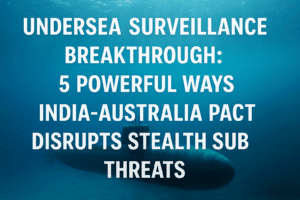Undersea Surveillance Breakthrough: 5 Powerful Ways India-Australia Pact Disrupts Stealth Sub Threats
Australia and India have launched their first joint defense science project to enhance undersea surveillance, targeting improved detection of submarines and autonomous underwater vehicles (AUVs). The three-year collaboration between Australia’s Defence Science and Technology Group (DSTG) and India’s Naval Physical and Oceanographic Laboratory will refine towed array sonar systems and advanced tracking algorithms. By combining expertise in signal processing and AI-driven Target Motion Analysis (TMA), the partnership aims to reduce false detections and improve real-time threat assessment.
This initiative comes amid growing Indo-Pacific tensions, where stealth submarines and AUVs are reshaping underwater warfare. The project strengthens defense ties between the two nations, aligning with broader alliances like AUKUS and the Quad. If successful, it could lead to next-generation sonar systems and deeper naval cooperation. Ultimately, the effort underscores the strategic importance of undersea dominance in modern maritime security.

Undersea Surveillance Breakthrough: 5 Powerful Ways India-Australia Pact Disrupts Stealth Sub Threats
In a significant step for Indo-Pacific security, Australia and India have launched their first joint defense science project, focusing on cutting-edge undersea surveillance technology. The three-year collaboration between Australia’s Defence Science and Technology Group (DSTG) and India’s Defence Research and Development Organisation (DRDO) aims to sharpen the detection and tracking of submarines and autonomous underwater vehicles (AUVs)—a critical capability as underwater warfare grows more complex.
Why This Collaboration Matters
With rising maritime tensions and the rapid advancement of underwater drones, the ability to monitor submarine activity is a strategic priority for both nations. China’s expanding submarine fleet and the proliferation of stealthy AUVs have made undersea surveillance a focal point for regional defense strategies.
This partnership leverages Australia’s expertise in towed array sonar systems—long, hydrophone-equipped cables dragged behind ships to detect faint acoustic signals—and India’s growing prowess in underwater defense research. By combining their strengths, the two countries hope to refine Target Motion Analysis (TMA), a key algorithmic method for tracking submerged threats without revealing the tracker’s own position.
How Towed Arrays and AI Could Change Undersea Warfare
Traditional sonar systems struggle with false signals and environmental noise, making it difficult to distinguish enemy submarines from natural ocean sounds. The joint project will explore:
- Advanced signal processing to filter out interference.
- Machine learning algorithms to predict submarine movements more accurately.
- Interoperability enhancements, ensuring Australian and Indian systems can share data seamlessly.
Dr. Sanjeev Arulampalam, a senior DSTG researcher, explains: “Towed arrays act like underwater ears, capturing sounds from all directions. By refining how we analyze these signals, we can detect threats earlier and with greater confidence.”
The Bigger Picture: AUKUS, Quad, and the Indo-Pacific
This initiative aligns with broader efforts to counter undersea threats in the Indo-Pacific. Australia’s AUKUS pact with the US and UK already focuses on nuclear-powered submarines, while the Quad (US, Japan, India, Australia) enhances maritime security cooperation.
By deepening defense ties with India—a key regional player with its own concerns about Chinese submarine activity—Australia is strengthening a strategic partnership that could reshape undersea warfare dynamics.
What’s Next?
If successful, the research could lead to:
- Next-gen sonar systems for allied navies.
- Improved tracking of stealth submarines and AUVs.
- Stronger Australia-India defense collaboration, potentially extending to joint naval exercises or technology sharing.
As Suneel Randhawa, DSTG’s Chief Information Sciences Division, puts it: “Innovation in undersea surveillance isn’t just about technology—it’s about staying ahead in an evolving battlespace.”
This project marks a new chapter in Indo-Pacific security, proving that science and strategy go hand in hand beneath the waves.
You must be logged in to post a comment.